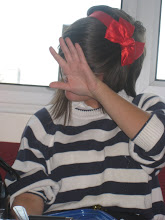 Hercules Seghers Hercules SeghersThe Enclosed Valley. 1620's. Etching with washes |
nd many forgeries exist. Rembrandt owned
several of his paintings and was obviously influenced by his landscapes.
Paul Gauguin (1848-1903) worked independently developing his own unique technique called trace monotype. His method consists of inking a sheet of paper, laying another sheet over it, and drawing on the fresh paper which received the ink in a linear manner.
Paul Klee (1879-1940) used and developed this method a few years later for his intriguing drawings. This seems very similar to the mono-printing of today.

In the workshop today we learnt what you can do with mono-print, and what the process is. You ink up a surface (we used acrylic), then to either cut out shapes or draw onto the ink and then put itthrough the press. The shapes cr eate the negative image...as you can see below.

Oh dear! This was the first mono-print i tried and it went horribly wrong. I disliked it so much that i stuck a couple of bits onto it.

When using cut out type shapes you must remember that it's reverse!


This was when I'd actually put the letters the correct way round!

This was done my drawing into the ink with a sharp edged object before putting it through the press.
Although it was pretty fun to do, I felt like I was back school, and the images that were produced and that I produced felt a little child-like. Perhaps this was because I didnt really know what i was doing. I didn't like not knowing what was actually going to be on my paper after printing it. I feel that for a certain project or an image with a certain subject it would be good to use, but i don't feel that any of the work i produce or will produce and especially not for wallpaper, that it would be appropriate to use. From exploring wallpaper, the repeat pattern and style is very structured and tidy, and i feel that you cant achieve this through mono-print.

No comments:
Post a Comment